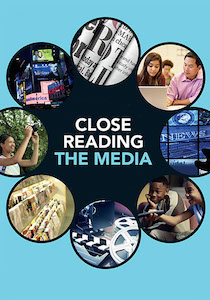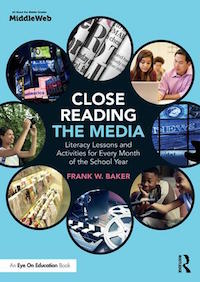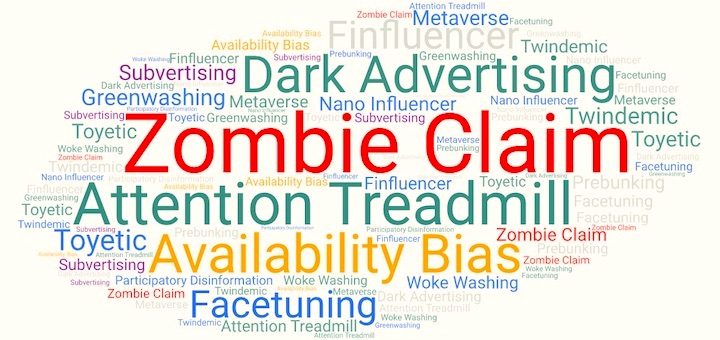Media Literacy Words to Intrigue Your Students
A MiddleWeb Blog

Do these words and phrases look familiar to you? They didn’t to me. But I encountered them while reading the news. After “looking them up,” I wondered how many of us know what they mean. (See their definitions at the bottom of this post.)
I was a late adopter to owning a mobile phone. So when I heard a commercial mention “roaming” all I could think about was that line from the song Home On The Range (“give me a home where the buffalo roam”). Without doing further research, I didn’t have a clue. Now that I own a phone, I know.
Over the past several decades, so much new media and technology has come into our lives and we’ve added thousands of new words and usages to our dictionaries to describe objects and actions never imagined by our ancestors.
The computer has “a mouse.” Mobile phones and tablets now have “apps.” Television and related devices employ DVRs (digital video recorders). Many of us are fans of “streamers.”
The constant introduction of new media and technology offers ongoing opportunities to add words and phrases to our students’ vocabulary. In many cases, those new expressions reveal something important about the way the media works (and seeks to manipulate us) and their definitions fall into the area of media literacy.
With that in mind, I recently began to post a weekly media literacy word or phrase of the week on my Facebook page (https://www.facebook.com/medialitman) and on my Twitter feed @fbaker.
Many of these words have become part of our popular culture vernacular, perhaps without us even understanding their exact meaning.
Timely words and phrases
With the start of the pandemic we were introduced to words/phrases like “contact tracing,” “infodemic,” “super spreader,” and “long-haulers” – words and phrases that were used frequently in the news.
At the same time, because I have been a long-time media literacy advocate, I wanted educators (and their students) to be aware of some common media literacy terms that may or may not appear in your state’s teaching standards. Here I am referring to bias, validity, techniques of persuasion, propaganda, stereotypes, representation, among many others.
Incorporating words and phrases into instruction
On the Media Literacy Word/Phrase of The Week webpage where I post weekly, I offer educators this advice:
- introduce the word/phrase
- challenge students to research the meaning of the word/phrase
- have them locate the word/phrase in a recent news story
Obviously, you won’t have to use only THIS week’s word or phrase. Choose any word and decide when and where it would be appropriate to use with your students.
Different groups employ their own words/phrases
Many middle grades educators have recently spent a great deal of their time helping students understand “fake news,” “conspiracy theory,” “disinformation,” “misinformation,” and “news literacy.”
Every year during the TV and film awards seasons, I begin to see, hear and read commonly used words and phrases. Examples here include “for your consideration,” “showrunner,” and “artistic license.”
During the election time of year, journalists and broadcasters employ phrases like “horse race,” “dark money,” “battleground states,” “direct-mail,” and “stagecraft.”
The advertising industry is one that often employs “insider” terminology. Examples include: “upfronts,” “behavioral targeting,” influencers, “dark advertising,” “demographics” and “product placement.”
The advancements in technology have introduced us to “artificial intelligence,” “deepfakes,” “ransomware,” “algorithm,” “facial recognition,” “net neutrality,” “twitter bots” and much more.
What new words and phrases do you want students to know?
No doubt you may have your own words or phrases you want students to know and understand.
It is my hope that you will consider engaging your students in any one of the weekly posted words and phrases on my web page.
Those three words at the top
Metaverse: “a virtual-reality space in which users can interact with a computer-generated environment and other users.”
Prebunking: “the process (most frequently seen in politics) of debunking lies, tactics, or sources before they strike.”
Participatory Disinformation: the process through which disinformation is spread through groups, technology and people – a process that has been supercharged by the advent of social media.
A dozen more words to get you started
Here are some other media literacy words and phrases you might have your students research, chosen from my collected weekly entries for 2021:
Attention treadmill – The practice of media companies to use algorithms that give users “more of the same,” narrowing their awareness of diverse news and points of view.
Republican Senator Josh Hawley of Missouri agreed with Harris that the business model of social media companies is built on bringing users back for more. “It’s an attention treadmill, it’s an addiction economy,” Hawley said. “They designed it this way, addiction is the design,” he added. (CBS News, 4/27/21)
Availability bias – Availability bias leads people to make false assumptions by assuming that if they hear something stated often enough, it must be true. For example:
- Frequently reported news stories are often mistaken for being regular occurrences.
- Misleading statements become more convincing the more often they are repeated.
- Commonly associated ideas begin to look like they are connected. (Neuromarketing Glossary – see examples)
Dark advertising – “Dark marketing is communicating & showing sponsored ads through various discreet channels where the consumer & the potential customer gets the message but cannot actually see the company & the advertiser.”
Wired magazine’s Jargon Watch says it is ““Discreetly sponsored online and real-world ads intended to reach the targeted audiences that would ordinarily shun corporate shilling.” (Source)
Related: Dark Social – “The term was coined to describe the traffic of online content sharing through private channels such as messaging apps (think WhatsApp), instant messaging (like Facebook Messenger), private email, and text messaging.” Though not easily tracked, it constitutes 80+% of social sharing. (Source)
Facetuning – Using an app to remove blemishes, improve complexions and perform other manipulations on facial photos, including selfies. Sometimes seen as undermining self and body confidence, particularly in younger users. Also see catfishing. (Source)
Finfluencer – A “finfluencer,” or finance influencer, is an influencer that shares financial information and expertise. Popular on TikTok.
“They offer Gen Z and Millennials financial advice in snackable, light-hearted formats and are becoming an increasingly popular source of financial information on social media.” (Source)
Greenwashing – Greenwashing (also called “green sheen”) “is a form of marketing spin in which green PR and green marketing are deceptively used to persuade the public that an organization’s products, aims and policies are environmentally friendly.” (Source)
“Volkswagen released an ad campaign to debunk the fact that diesel was bad and that it used a technology where it emitted fewer pollutants. Later, the truth was revealed that Volkswagen rigged 11 million of its diesel cars with “defeat devices,” or technology designed to cheat emissions tests and that the vehicles emitted pollutants at levels up to 40 times the U.S. limit.” (Source)
Nano-Influencer – “Nano-influencers are your everyday social media users, with anywhere from 100 to 10,000 followers. They aren’t professional “influencers” in any way – and the majority of their posts feature typical content like photos of their family, friends, cat videos, and memes.”
“Unlike traditional influencers who are paid by brands to influence their followers and curate a specific aesthetic, nano-influencers typically receive little to no pay, and instead receive free product or services in exchange for posting on their social media platform. (B)ecause nano-influencers aren’t in the business of regularly recommending products…when they do post about a product or service, it often comes across as more authentic or genuine.” (Source)
Subvertising – “Subvertising is the practice of making spoofs or parodies of corporate and political advertisements.
“A well-produced ‘subvert’ mimics the look and feel of the targeted ad, promoting the classic ‘double-take’ as viewers suddenly realize they have been duped. Subverts create cognitive dissonance, with the apparent aim of cutting through the ‘hype and glitz of our mediated reality’ to reveal a ‘deeper truth within’.” (Source)
Toyetic – Toyetic is a term referring to the suitability of a media property, such as a cartoon or movie, for merchandising tie-in lines of licensed toys, games and novelties. Notable earlier examples include Star Wars and Transformers. (Source)
Twindemic – “Twindemic is a term used during the COVID-19 pandemic, referring to the possibility of a severe flu season happening alongside….” producing rare cases of Flurona. (Source)
Woke washing – “Woke-washing is a term used to define practices in business that provide the appearance of social consciousness without any of the substance. A woke-washed business could theoretically promote the opposite of racial equality within its walls while championing causes of social justice to the outside world.” (Source) Compare to greenwashing.
Zombie claim – A false claim refuted by research that crops up repeatedly in social media. ‘However many times you rebut them, these zombie claims refuse to die.’” The alledged stolen 2020 election is one example. Another:
“The Washington Post’s ‘Fact Checker’ argued that the current and future gulf between the number of Navy ships and the missions assigned to the U.S.’s sea services is a zombie claim.” (Source)

Baker is the author of Close Reading The Media a collaboration with MiddleWeb and Routledge Eye on Education. He frequently conducts media literacy workshops with K-12 teachers. Contact him at fbaker1346@gmail.com and follow him on Twitter @fbaker.

































Here are a few more “leftover” words from Frank Baker’s collection, to share with your media-savvy students:
Geo spoofing – The process of hiding a true location by making a device appear to be in a different location than it really is.
“Geo-spoofing is…hugely popular and usually achieved by using a VPN. There are lots of reasons to use geo-spoofing but the most common are to access blocked content, apps and streaming services or to conceal your real location to protect your privacy.” (Source)
IKEA Effect – A tendency to overvalue items that we have customized or built ourselves.
“When subjects were invited to assemble IKEA furniture, origami or Lego structures, they saw their own amateurish products as equivalent in value to those of professionals. They also expected other people to value them similarly.” (Source)
Ransomware – “Ransomware is malware that employs encryption to hold a victim’s information at ransom. A user or organization’s critical data is encrypted so that they cannot access files, databases, or applications. A ransom is then demanded to provide access.”
“It is a growing threat, generating billions of dollars in payments to cybercriminals and inflicting significant damage and expenses for businesses and governmental organizations [including school systems].” (Source)
Revenge travel – “Pent-up demand to travel freely again, or as freely as can be under COVID restrictions, has resulted in an increase in “revenge travel.” That has come to mean the strong desire to travel even more than before the onset of the pandemic—more about getting revenge on the coronavirus and more than a year lost to lockdowns.” (Source)